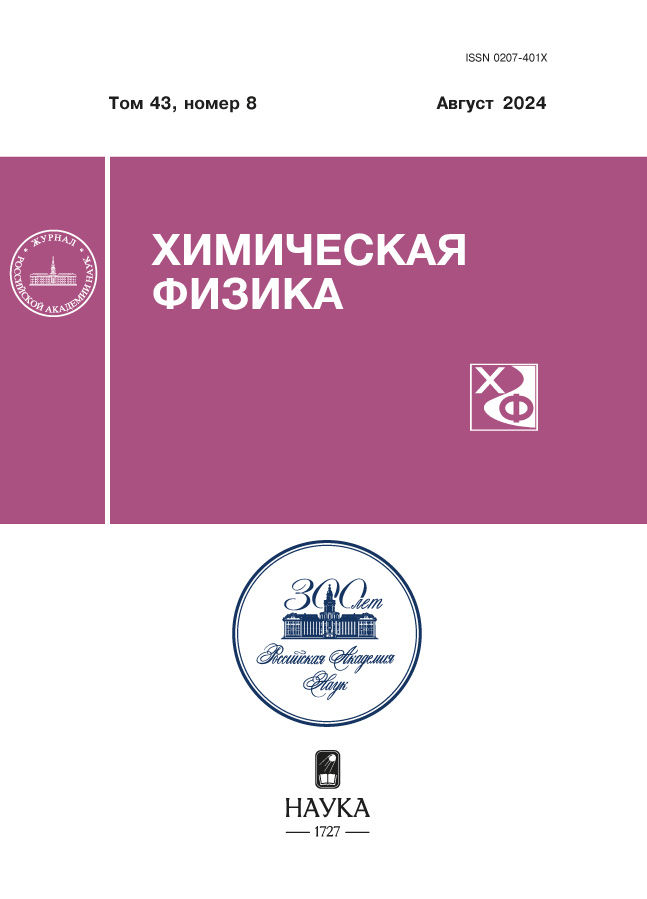Experimental study of a stoichiometric propylene–oxygen–argon mixture ignition behind a reflected shock wave
- Authors: Kozlov P.V.1, Kotov M.A.1,2, Gerasimov G.Y.1, Levashov V.Y.1, Bykova N.G.1, Zabelinskii I.E.1
-
Affiliations:
- Moscow State University
- Ishlinsky Institute for Problems in Mechanics, Russian Academy of Sciences
- Issue: Vol 43, No 8 (2024)
- Pages: 42-48
- Section: Combustion, explosion and shock waves
- URL: https://cijournal.ru/0207-401X/article/view/681883
- DOI: https://doi.org/10.31857/S0207401X24080056
- ID: 681883
Cite item
Abstract
A study on the self-ignition of a propylene–oxygen–argon stoichiometric mixture with a volumetric argon content of 95% was carried out. The experiments were performed on a shock tube, which is part of the “Shock Tube” experimental complex of the Institute of Mechanics of Moscow State University, in conditions behind the reflected shock wave. The time dependences of signals from a piezoelectric pressure sensor, a thermoelectric detector and an optical section configured to record the radiation of electronically excited radicals OH• (l = 302 nm), CH• (l = 427 nm, and molecular carbon C2• (l = 553 nm) were analyzed. The ignition delay times τign were measured in the temperature range T = 1200–2460 K and pressures p = 4.5–25 atm. The data obtained are compared with the results of other authors.
Keywords
Full Text
About the authors
P. V. Kozlov
Moscow State University
Email: vyl69@mail.ru
Institute of Mechanics
Russian Federation, MoscowM. A. Kotov
Moscow State University; Ishlinsky Institute for Problems in Mechanics, Russian Academy of Sciences
Email: levashovvy@imec.msu.ru
Institute of Mechanics
Russian Federation, Moscow; MoscowG. Ya. Gerasimov
Moscow State University
Email: vyl69@mail.ru
Institute of Mechanics
Russian Federation, MoscowV. Yu. Levashov
Moscow State University
Author for correspondence.
Email: levashovvy@imec.msu.ru
Institute of Mechanics
Russian Federation, MoscowN. G. Bykova
Moscow State University
Email: vyl69@mail.ru
Institute of Mechanics
Russian Federation, MoscowI. E. Zabelinskii
Moscow State University
Email: levashovvy@imec.msu.ru
Institute of Mechanics
Russian Federation, MoscowReferences
- G.L. Agafonov and A.M. Tereza, Russ. J. Phys. Chem. B 9, 92 (2015).
- K.C. Lin and C.-T. Chiu, Fuel 203, 102 (2017).
- K.L. Tay, W. Yang, B. Mohan, H.A.D. Zhou, and W. Yu, Energy Conver. Manage. 108, 446 (2016).
- G.Ya. Gerasimov, Yu.V. Tunik, P.V. Kozlov, V.Yu. Levashov, I.E. Zabelinskii, N.G. Bykova, Russ. J. Phys. Chem. B 15, 637 (2021).
- S.G. Davis, C.K. Law, and H. Wang, Combust. Flame 119, 375 (1999).
- A.D. Kiverin, K.O. Minaev, and I.S. Yakovenko, Russ. J. Phys. Chem. B 14, 614 (2020).
- S. Dong, K. Zhang, P.K. Senecal et al., Proc. Combust. Inst. 38, 611 (2021).
- X. Liang, S. Zhu, X. Wang, and K. Wang, Fuel 302, 121130 (2021).
- A. Ramalingam, S. Panigrahy, Y. Fenard, H. Curran, and K.A. Heufer, Combust. Flame 223, 361 (2021).
- J.-Y. Jia, M. Wen, Z.-H. Zheng, X.-P. Yu, Y.-Z. Yao, and Z.-Y. Tian, Fuel 353, 129199 (2023).
- S.M. Burke, U. Burke, R. McDonagh et al., Combust. Flame 162, 296 (2015).
- M.A. Kotov, H.V. Kozlov, G. Ya. Gerasimov et al., Russ. J. Phys. Chem. B 16, 655 (2022).
- A.M. Tereza, G.L. Agafonov, E.K. Anderzhanov et al., Russ. J. Phys. Chem. B 14, 654 (2020).
- P.N. Brevnov, L.A. Novokshonova, V.G. Krasheninnikov et al., Russ. J. Phys. Chem. B 13, 825 (2019).
- R.K. Hanson and D.F. Davidson, Prog. Energy Combust. Sci. 44, 103 (2014).
- P.V. Kozlov, G.Ya. Gerasimov, V.Yu. Levashov, Yu.V. Akimov, I.E. Zabelinsky, and N.G. Bykova, Russ. J. Phys. Chem. B 15, 827 (2021).
- A Chemical Equilibrium Program for Windows. http://www.gaseq.co.uk/
- S. Dong, K. Zhang, P.K. Senecal et al., Proc. Combust. Inst. 38, 611 (2021).
- J. Shao, D.F. Davidson, and R.K. Hanson, Fuel 225, 370 (2018).
- E. Carbone, F. D’Isa, A. Hecimovic, and U. Fantz, Plasma Sources Sci. Technol. 29, 055003 (2020).
Supplementary files















